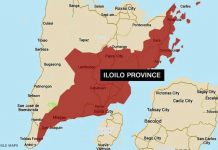ILOILO City – A structural engineer has voiced concerns regarding the Department of Public Works and Highways (DPWH) Region 6’s plan to fully open the Ungka flyover in Barangay Ungka II, Pavia, Iloilo, on December 25.
Engineer Nilo Jardeleza would like to see is a thorough addressing of the flyover’s vertical displacement (sinking) specifically at piers 4, 5, and 6 because jet grouting may not be enough.
Jet grouting is a construction technique used to improve ground stability by injecting a high-pressure mixture of cement, water, and sometimes additives into the soil. The process involves drilling down into the ground and then injecting the grout mixture at high pressure, creating a hardened soil-cement column that reinforces weak or loose soil. This technique is widely used to stabilize foundations, prevent settlement, and enhance load-bearing capacities in projects like bridges, tunnels, and embankments.
Jardeleza recalled raising his concern to DPWH-6 earlier this year after seeing social media photos showing settlement in certain piers of the Ungka flyover despite the application of jet grouting. He himself photographed the flyover, where settlement remains visible at some piers.
“There should be an investigation, as the cause of the settlement might not be limited to the area alone; environmental factors may also be at play,” Jardeleza said.
While DPWH-6 responded that all piers passed testing and showed no settlement post-jet grouting, Jardeleza questioned why the flyover has been opened partially to motorists while jet grouting continues.
“Even a slight vibration could disturb the bond or connection from jet grouting. We raised this concern in May. By July, we observed that Pier No. 1 had subsided,” he said.
Jardeleza admitted a persistent worry that Pier No. 1 could still “give way” despite undergoing jet grouting and testing.
“I still suspect it might give way, even with jet grouting. Jet grouting is effective, but there remains a chance for sinking due to substantial groundwater extraction in both confined and unconfined aquifers beneath,” Jardeleza explained, citing data from Pavia’s local government.
His primary concern centers on confined aquifers, which are in a liquefiable layer. If groundwater is extracted, the ground pressure decreases, weakening the soil’s grip around the piers.
“When groundwater is extracted, pressure and soil cohesion around the piers lessen, potentially leading to settlement. Groundwater pumping is continuous in Pavia and San Miguel towns to supply Iloilo City and neighboring towns with water,” he explained.
Jardeleza recalled a recommendation from third-party consultant Abinales Associates Engineers + Consultants, suggesting the addition of four bored piles in areas showing displacement. DPWH-6, however, chose not to follow this advice, as results from dynamic and static load tests conducted by DPWH indicated no further movement or settlement. Thus, DPWH proceeded with jet grouting across all piers in consultation with Abinales.
Jardeleza pointed out that test results conducted by DPWH-6 only reflect the status at the time of testing and may not capture ongoing environmental developments affecting the structure.
“DPWH’s testing is accurate for the day it was done, but as time progresses, environmental changes could impact the structure in ways beyond their control,” Jardeleza said.
He warned of the possibility that the piers may continue to settle despite jet grouting, as the piers rely on the ground pressure of the surrounding soil. Given that the soil is saturated and liquefiable, there is a likelihood of future movement./PN





